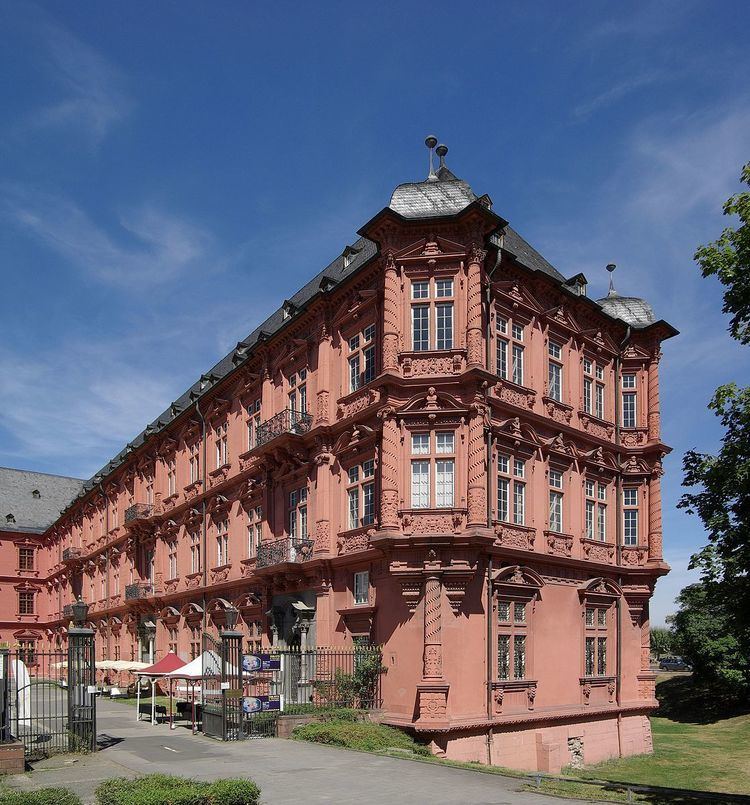Established 1852 Founded 1852 | Location Mainz, Germany Phone +49 6131 9124133 Director Falko Daim | |
 | ||
Collection size The Old World and its contact zones from the Stone Age to the Middle Ages Address Ernst-Ludwig-Platz 2, 55116 Mainz, Germany Hours Open today · 10AM–6PMWednesday10AM–6PMThursday10AM–6PMFriday10AM–6PMSaturday10AM–6PMSunday10AM–6PMMondayClosedTuesday10AM–6PMSuggest an edit Similar Museum für Antike Schiffahrt, Landesmuseum Mainz, Electoral Palace - Mainz, Monrepos, Gutenberg Museum Profiles | ||
The Romano-Germanic Central Museum (German: Römisch-Germanisches Zentralmuseum (RGZM)) is an archaeological and historical research institution for pre-history and early history headquartered in Mainz. It is supported by the Federal Republic of Germany and its states and is a member of the Leibniz Association of German research institutions.
Contents
The institution studies the Old World and its contact zones from the Stone Age to the Middle Ages. It consists of several divisions, and in addition maintains a permanent collection and through this and its numerous publications and conferences, disseminates the findings of recent research to the public.
History
The Romano-Germanic Central Museum was founded in 1852 by Ludwig Lindenschmit the Elder, after the decision was taken at the 16–19 August Versammlung deutscher Geschichts- und Alterthumsforscher (Assembly of German Researchers in History and Classical Studies) in Dresden that a "central museum for Germanic and Roman artifacts" should be founded in Mainz and a "Germanic museum" should be founded in Nuremberg (the Germanisches Nationalmuseum). It was no accident that the museum was established in the city of Mainz, with its high importance in the Middle Ages, and housed in the Electoral Palace; rather these decisions symbolised the museum's national aspirations in the era of the German Confederation.
In the early years of its existence, the museum faced considerable financial and organisational problems: the support which had been promised by the historical association failed to materialise, and instead the Nuremberg museum was promised exclusivity and the governing board of the Mainz museum were pressured to amalgamate with it. Only after the foundation of the German Empire in 1871 did the museum receive an annual budget, which also made it possible for Lindenschmit to make his work there his primary pursuit; until then, he had also worked as a drawing teacher. After his death, his son Ludwig Lindenschmit the Younger took over the leadership.
In 1900, Karl Schumacher became the first director of the museum, a position which he would hold for 25 years. He increased its size from four to 27 rooms of exhibits, had further copies and reconstructions created in the museum's own workshop and published 297 works under his own name in addition to numerous catalogues, in particular the three-volume Siedlungs- und Kulturgeschichte der Rheinlande.
The elder Lindenschmit conceived of the museum as a research collection of copies, which would include all significant finds made in Germany, or even the whole of Europe, in order to facilitate comparative studies. The museum in Mainz still has the character of a research collection, aimed more at scholars and those interested in the field than at the public in general. In recent years, the museum has also offered "programmes for instructors" and special exhibitions devoted to current research. Although the institution has at times also taken some responsibility for heritage preservation in Rhenish Hesse, including conducting their own excavations, the restoration workshops still constitute today the foundation of their scholarly work, while field investigations are primarily conducted by the annexes in Neuwied and Mayen.
In early December 2007, the museum announced plans for a new building on the southern edge of Mainz, next to the Museum of Ancient Seafaring which is one of its annexes.
Some major German archaeologists have worked and work at the Romano-Germanic Central Museum, including Ludwig Lindenschmit the Younger, Paul Reinecke, Friedrich Behn, Kurt Böhner, Konrad Weidemann and Markus Egg. The current Director General is Falko Daim.
Research emphases
Researchers from different divisions work together on emphasised themes which cross boundaries between divisions and periods:
In presenting research, the museum works closely with the Volcano Park in Mayen-Koblenz. One emphasis is research into the use of volcanic rock as building materials and for millstones, particularly in the Roman period. Rock from the Eastern Eifel was used to build the Roman settlement of Colonia Ulpia Traiana at Xanten and was exported as far as southern Scandinavia.
The museum forms part of the Research Centre for Earth System Disciplines founded in 2008 at the University of Mainz, and of Byzantine Archaeology Mainz, which takes up themes of modern interdisciplinary inquiry into the archaeological evidence on the Byzantine Empire.
Research divisions
The Romano-Germanic Central Museum has several divisions and annexes. The Electoral Palace in Mainz houses three divisions:
Several research areas are attached to these divisions.
In the Museum of Ancient Seafaring in Mainz:
In Castle Monrepos at Neuwied, the Museum of Ice Age Archaeology:
In Mayen:
The Romano-Germanic Central Museum also currently has an extension programme in China.
Restoration workshops
The work of the Romano-Germanic Central Museum is focussed more on artifacts than on conducting field research. This has come to be so because of the museum's rich tradition and important work in restoration workshops; amongst others, they have worked on Ötzi the Iceman's equipment and the bronze boar from Soulac-sur-Mer. They also train restorers, and a BA degree in museum restoration is offered jointly with the University of Mainz. At the request of the State of Rhineland-Palatinate, the museum and the university have also jointly set up a centre for mineralogical archaeometry and conservation studies.
Publications
The museum's history of publications in the field of archaeology goes back to 1852. They publish several scholarly journals, since 2006 in cooperation with Schnell und Steiner in Regensburg.
Additionally, they publish scholarly monographs and a recently instituted series for a popular readership.
Exhibits
In addition, the museum participates in international exhibitions, but there is rarely space to display these at Mainz.
